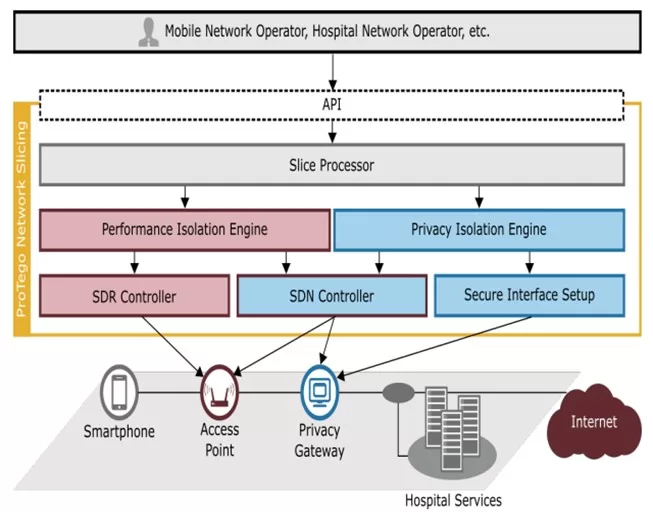Understanding eNPN
Enhanced Non-Public Networks (eNPN) represent a significant advancement in 5G technology, specifically tailored for industrial needs. Unlike traditional Non-Public Networks (NPNs) that offer basic isolation and customization, eNPNs incorporate advanced 5G features like ultra-reliable low-latency communication (URLLC), enhanced mobile broadband (eMBB), and massive machine-type communications (mMTC). This makes eNPNs more flexible and efficient, capable of supporting a wider range of applications and use cases.
The deployment of eNPNs varies according to industry requirements. The 5G Alliance for Connected Industries and Automation (5G-ACIA) has outlined key scenarios that demonstrate the diverse applications of eNPNs:
Table 1: 5G-ACIA scenarios with 3GPP NPN categories
| 5G-ACIA Scenario | 3GPP NPN Category | Description/Comments |
| #1: Isolated NPN | SNPN | All 5GS functions are owned by the enterprise customer and deployed on-premises. |
| #2: Shared RAN | SNPN | Incorporates RAN sharing, serving both non-public and public subscribers. |
| #3: Shared RAN and CP | PNI-NPN | Network functions in 5GC CP vary based on specific use cases and vertical customer requirements. |
| #4: NPN hosted by the public network | PNI-NPN | PLMN enables end-to-end connectivity for non-public subscribers to the LADN. |
The focus here is to unravel the layers of eNPNs — understanding what sets them apart from their predecessors, how they have evolved, and why they are becoming increasingly vital for industry-specific deployments. We will delve into the nuances of these networks, exploring their architecture, capabilities, and the new vistas they open in the realm of 5G connectivity.
In doing so, we will paint a comprehensive picture of how Enhanced Non-Public Networks are not just supporting the current industrial needs but are also shaping the future of industry-specific wireless solutions.
Key Features of eNPN in Release 18
Release 18 of the 5G standards has been a game-changer for eNPNs. It introduced several key features that significantly enhance the functionality and applicability of these networks:
- Advanced Security Protocols: eNPNs in Release 18 incorporate robust security measures, ensuring data integrity and protection against cyber threats, which is paramount for industries handling sensitive information.
- Improved Scalability: These networks are designed to efficiently scale up or down, accommodating the dynamic needs of businesses, from small-scale operations to large industrial complexes.
- Enhanced Connectivity and Coverage: eNPNs provide improved coverage and connectivity, ensuring seamless communication even in challenging environments typical to industrial settings.
- Customized Service Capabilities: With Release 18, eNPNs offer tailored services, including prioritization of network resources and customized Quality of Service (QoS) profiles, aligning with specific industry requirements.
- Interoperability with Public Networks: One of the critical advancements is the enhanced ability of eNPNs to seamlessly integrate and coexist with public 5G networks, allowing for flexible deployment models.
- Support for Diverse Applications: From IoT integration to supporting autonomous machinery, eNPNs are equipped to handle a wide range of industrial applications, paving the way for innovative use cases.
By embracing these advancements, Enhanced Non-Public Networks in Release 18 not only address the immediate challenges faced by industries today but also open up new possibilities for future technological innovations. As industries continue to evolve in the digital era, eNPNs stand out as a key enabler, offering the versatility, security, and efficiency needed to drive this transformation.
Comparative Analysis with Previous Releases
Comparing Release 18 with Releases 16 and 17, the advancements are not just incremental but transformative. While earlier releases laid the groundwork for NPNs, focusing on basic framework and initial features, Release 18 builds upon this foundation with substantial improvements in security, scalability, and interoperability. These enhancements reflect a deeper understanding of industrial requirements and a commitment to addressing them more effectively with eNPNs.
eNPN for Scalable Industry Deployments
Enhanced Non-Public Networks (eNPN) in Release 18 of 5G standards bring a new dimension of scalability to industry deployments. This scalability is key in adapting to the dynamic nature of industrial operations, where requirements can vary greatly in size, complexity, and functionality.
Balancing Efficiency and Cost-Effectiveness
One of the greatest advantages of eNPNs is their ability to balance operational efficiency with cost-effectiveness. By scaling network resources to match current demands, industries can avoid the unnecessary expense of maintaining a network larger than their needs, while still having the flexibility to expand as required.
Core Security Features in eNPN
eNPN in Release 18 of the 5G standards address the need of Enhanced Security in Industry, offering a fortified security framework specifically tailored for industrial environments.
- Advanced Encryption Protocols: eNPNs employ state-of-the-art encryption techniques to safeguard data transmission across the network, ensuring that sensitive information remains secure from external threats.
- Strict Access Control: These networks implement stringent access control mechanisms, restricting network access to authorized devices and users only. This minimizes the risk of unauthorized access and potential breaches.
- Network Segmentation: eNPNs allow for the creation of segmented network zones. This segmentation is crucial for containing potential security incidents, preventing them from impacting the entire network.
- Continuous Monitoring and Threat Detection: eNPNs are equipped with sophisticated monitoring tools that continuously scan the network for suspicious activities, enabling prompt detection and mitigation of potential threats.
Case Studies: Implementing eNPN in Healthcare Environments
Several industries have already begun reaping the benefits of eNPN’s scalability. In healthcare, eNPNs support telemedicine, remote monitoring of patients, and the secure transfer of sensitive medical data. They enhance the capabilities of healthcare providers to deliver timely and effective care.
- Network Slicing for Customized QoS: The concept of network slicing in eNPN allows for the creation of customized network segments, each tailored to specific healthcare applications. This ensures that critical services like real-time patient monitoring receive the necessary bandwidth and low latency, while other services are managed efficiently within the network.
- Enhanced Security and Privacy: eNPNs offer advanced security protocols, essential in healthcare for protecting sensitive patient data. The integration of technologies like secure network interfaces and encryption ensures the confidentiality and integrity of medical data, from the point of capture to storage.
- Performance Isolation Over WiFi Networks: In healthcare settings, the performance isolation capabilities of eNPNs enable the prioritization of network traffic. This ensures that essential healthcare services, such as telemedicine consultations or emergency response systems, maintain high-quality connectivity without interference from other network traffic.
- Dynamic Allocation and Deallocation of Network Resources: eNPNs support dynamic network resource management, allowing healthcare facilities to adapt quickly to varying network demands. This flexibility is crucial for managing the fluctuating network load, typical in healthcare environments with diverse and intermittent application usage.
The ProTego project illustrates the practical application of eNPN network slicing in a hospital environment.
ProTego’s network slicing architecture comprises multiple layers, including input processing from external actuators, performance and privacy rule generation, and the management of traffic prioritization and security.

Figure 1: ProTego Basic Architecture
The system integrates components like Software-Defined Radio (SDR) controllers and Software-Defined Networking (SDN) controllers, along with secure interface setup for data encryption.
The implementation of ProTego network slicing in hospitals ensures performance isolation for critical healthcare services and privacy isolation, safeguarding sensitive patient data across the network.
Challenges and Considerations
While eNPN in Release 18 of 5G standards offer significant advantages for various industries, their deployment and operation come with a set of challenges and considerations. Addressing these issues is crucial for maximizing the benefits of eNPNs and ensuring their successful integration into different industrial environments.
- Technical Complexity: Setting up and managing an eNPN requires a deep understanding of 5G technologies and network management. This complexity can pose challenges, especially for organizations without in-house expertise.
- Integration with Existing Systems: Many industries already have established networks and systems. Integrating eNPNs with these existing infrastructures without causing disruptions or compatibility issues is a significant challenge.
- Cost Implications: The initial investment for deploying an eNPN, including infrastructure and technology upgrades, can be substantial. Organizations need to balance the cost against the anticipated benefits and ROI.
- Regulatory Compliance: Navigating the regulatory landscape, which can vary significantly across regions and industries, is a challenge. eNPNs must comply with all relevant laws and regulations, particularly those related to data security and privacy.
- Security Concerns: While eNPNs enhance security, they also become targets for cyberattacks. Ensuring the ongoing security of these networks requires constant vigilance and updates to counter new threats.
Conclusion
The advent of Enhanced Non-Public Networks (eNPN) in Release 18 of 5G standards marks a significant milestone in the evolution of industrial connectivity. These networks, with their advanced 5G capabilities such as URLLC, eMBB, and mMTC, offer unprecedented flexibility and efficiency, making them a crucial tool for industries navigating the complexities of the digital era.
The key features introduced in Release 18 — including advanced security protocols, improved scalability, enhanced connectivity, and customized service capabilities — not only address the immediate challenges faced by industries but also pave the way for future innovations.
Particularly noteworthy is the application of eNPNs in the healthcare sector, where their scalability, security, and network management capabilities are revolutionizing medical services. Projects like ProTego demonstrate the practical utility of eNPNs in creating secure, reliable, and efficient healthcare environments, enhancing patient care and data protection.
However, the deployment of eNPNs is not without its challenges. Technical complexity, integration with existing systems, cost implications, regulatory compliance, and security concerns are key considerations that industries must navigate for successful implementation. Despite these challenges, eNPNs stand out as a transformative technology, offering the versatility, security, and efficiency needed to drive industrial transformation. By strategically addressing these challenges, industries can fully leverage the potential of eNPNs, ensuring their integration enhances operational efficiency and paves the way for future technological advancements.
References
- De Resende et al, “Enabling QoS-secured Enhanced Non-Public Network Slices for Health Environments”. Proceedings of the 6th EAI International Conference on Smart Objects and Technologies for Social Good. https://doi.org/10.1145/3411170.3411244
- Jose Ordonez-Lucena et al, “The use of 5G Non-Public Networks to support Industry 4.0 scenarios”, 2019.

